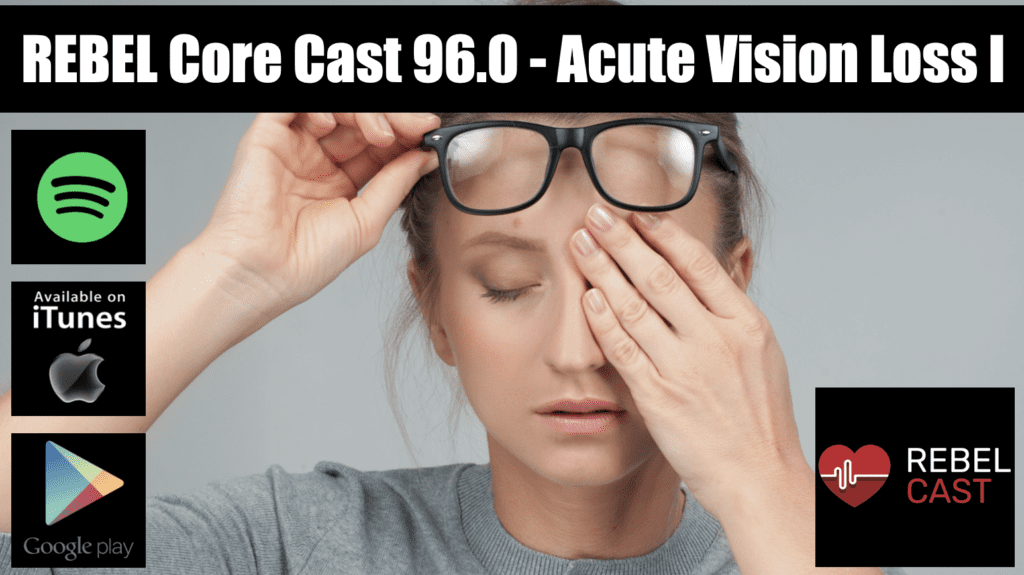
- Suspect glaucoma in any patient with an acute change in vision and get an intraocular pressure measurement
- First line treatment in acute angle closure glaucoma is a topical beta blocker
- Consider giant cell arteritis in patients with unilateral headache, jaw claudication and change in vision
- Don’t wait for the biopsy to start steroids in giant cell arteritis as this therapy is vision saving
REBEL Core Cast 96.0 – Acute Vision Loss I
Definition: Decrease of visual acuity due to a non-traumatic cause. Transient vision loss defined as vision loss <24 hours. Persistent vision loss defined as loss of vision >24 hours. (Bagheri 2015).
Causes: There are multitude of causes of vision loss. This post focuses on the following pathologies:
- Glaucoma
- Giant Cell Arteritis
- Vitreous Detachment
- Retinal Detachment
- Central Retinal Vein Occlusion
- Central Retinal Artery Occlusion
- Amaurosis Fugax
Glaucoma (Weinreb 2014, Schmidl 2015)
Definition: A group of diseases that have increased intraocular pressure (IOP), causing damage the optic nerve leading to decreased vision.
|
Open angle |
Closed angle |
|
|
Definitions |
Increased resistance to aqueous outflow through the trabecular meshwork. |
Access to the drainage pathways is obstructed |
|
Pathophysiology |
Increase in IOP; Exact etiology unclear, but has a normal appearing anterior chamber angle and raised intraocular pressure (IOP). Asymptomatic until late in disease after vision loss occurs. Most common type of glaucoma |
Occurs with obstruction to aqueous outflow, usually from the iris. Most common cause: pupillary block. |
|
Symptoms |
Generally painless, asymptomatic. May have blurred vision or decreased visual acuity. |
Painful vision loss, classically when going into a dark room. Other symptoms include halos around lights, nausea and vomiting. |
|
Signs |
IOP >21. Decreased visual acuity, Cup to disc ratio >0.6 (difficult to see due to corneal edema) |
IOP >21 (often >60), conjunctival injection, corneal edema, pupil that is hazy, fixed, mid-dilated. Cup to disc ratio >0.6 (difficult to see due to corneal edema) |
Emergency Department Management
-
- All patients should get emergency ophthalmologic consultation
- Start with eye drops (see table below) and add systemic medications if severe or refractory symptoms/IOP.
- 1st line med: Timolol (beta blocker)
- Topical meds can be given simultaneously except for pilocarpine, which is given after IOP is < 40 mmHg.
|
Drug |
Class |
Dose |
Mechanism |
Side effects |
|
Timolol 0.5% |
Beta blocker |
1 gtt |
Reduces production of aqueous humor via decreasing cAMP concentration in the ciliary body |
Can cause systemic effects, so if the patient has any contraindication to beta blocker, don’t use it. (contraindications = asthma, chronic obstructive pulmonary disorder, and patients with second and third degree heart blocks) |
|
Apraclonidine 1% |
Alpha agonist |
1-2 gtt |
Reduces production of aqueous humor plus increases outflow via contraction of the ciliary body |
CNS effects and respiratory arrest in young children; caution in patients with cerebral or coronary insufficiency, postural hypotension, and renal or hepatic failure |
|
Pilocarpine 1-2% |
Cholinergic |
1 gtt Q15 mins until IOP <40 Given after Timolol |
Causes iris to contract (miosis), which opens the canal more. Also can contract smooth muscle cells in the ciliary body, leading to an increase in aqueous outflow by widening the trabecular mechwork and Schlemm’s canal |
Ciliary spasm leading to headaches in young patients Ineffective at IOP >40 mmHg |
|
Latanoprost |
Prostaglandin |
1 gtt |
Increase drainage through the uveoscleral outflow path. |
Minimal systemic adverse effects; may be related to headaches |
|
Acetazolamide |
Carbonic anhydrase inhibitor |
500 mg IV/PO |
Reduces production of aqueous humor (CA makes bicarb, which is a major component of the aqueous humor) |
Topical form has minimal systemic adverse effects; oral form may be associated with paresthesia, nausea, diarrhea, loss of appetite and taste, lassitude, or renal stones. Caution in sickle cell patients. |
|
Mannitol |
Hyperosmotic agent |
1-2 grams/Kg IV |
Reduces production of aqueous humor. |
To minimize cerebral effects, and typically reserved if topical medications and acetazolamide do not work within 1 hour (from Rosens) |
Pro Tip: Can decrease systemic absorption of topical drops by putting pressure over medial surface of eye (over lacrimal duct) while placing drops.
Giant Cell Arteritis (arteritic anterior ischemic neuropathy) (Bagheri 2015, Hayreh 2009)
Pathophysiology
- Giant cell arteritis(GCA) affects that medium-sized and large arteries.
- T-cell-dependent disease.
- Predilection to involve the posterior ciliary artery. If not treated promptly, can cause profound bilateral visual loss without expeditious systemic corticosteroid treatment
Symptoms
- Often present with systemic symptoms, including anorexia and weight loss, malaise, myalgias
- Jaw claudication (can have tongue claudication as well)
- Headache (⅔ have this as primary symptom)
- Scalp tenderness
- Abnormal temporal artery and neck pain, myalgia, malaise and anemia.
- Transient unilateral vision loss (amaurosis fugax)
- Eye itself is usually painless.
Signs
- Decreased visual acuity common, but normal visual acuity does not rule out disease.
- Funduscopic exam:
- Classic finding is a pale ‘‘chalky white” swollen optic nerve head (70% of patients) (Hyreh 1998)
- Relative APD.
Lab tests
- Erythrocyte sedimentation rate (ESR).
- Typically will see marked elevation.
- A normal ESR does not rule out GCA
- C-reactive protein (CRP): CRP is the more sensitive marker for GCA
- Get both, because a positive ESR and CRP is close to 100% specific (Hayreh 2009)
- Gold standard test: temporal artery biopsy
Emergency Department Management:
- Ophthalmology/rheumatology consultation
- Prednisone: 80-100 mg Q24
- Ideally, start steroids after biopsy performed
- If high suspicion, start empiric steroids as unlikely to markedly alter biopsy results
- Duration of steroids (Hayreh 2009)
- Until the CRP and ESR go back down to normal
- Often takes 2-3 weeks.
- Followed by a steroid taper
Take Home Points
- Suspect glaucoma in any patient with an acute change in vision and get an intraocular pressure measurement
- First line treatment in acute angle closure glaucoma is a topical beta blocker
- Consider giant cell arteritis in patients with unilateral headache, jaw claudication and change in vision
- Don’t wait for the biopsy to start steroids in giant cell arteritis as this therapy is vision saving
Read More
Bhatia K, Sharma R: Eye Emergencies in Adams J.G. et al, Emergency Medicine Clinical Essentials ed 2. Philadelphia: Elsevier, 2013 (Ch) 26: p. 209-225
Walker R, Adhikari S.: Eye Emergencies, in Tintinalli J et al (eds): Tintinalli’s Emergency Medicine: A Comprehensive Study Guide, Seventh Edition New York City: McGraw-Hill 2016 (Ch) 241
Guluma K, Lee JE. Ophthalmology, in Marx J et al (eds): Rosens Emergency Medicine: Concepts and Practice, ed 9. Philadelphia: Elsevier, 2018 (Ch) 61: p. 790-819
EM docs: Central Retinal Artery Occlusion
CanadiEM: Medical Concepts – Acute Angle Closure Glaucoma
Post Created By: Anand Swaminathan MD, MPH
Post Peer Reviewed By: Salim R. Rezaie, MD (Twitter: @srrezaie)




